Nosler 77 grain BTHP
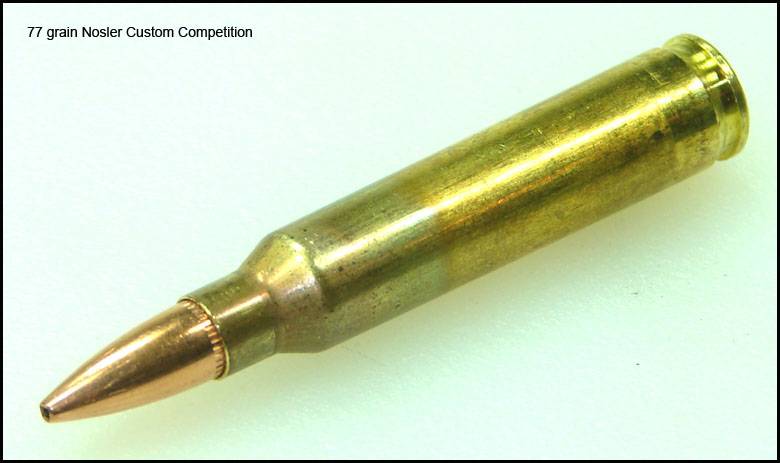
Nosler introduced their 77 grain Custom Competition BTHP bullet as an obvious competitor to the 77 grain Sierra MatchKing. The shape and ballistic coefficient of the Nosler bullet is very similar to that of the Sierra MatchKing. The Nosler bullet does have one major difference from the Sierra MatchKing; it is constructed using the thinner J4 copper jacket.
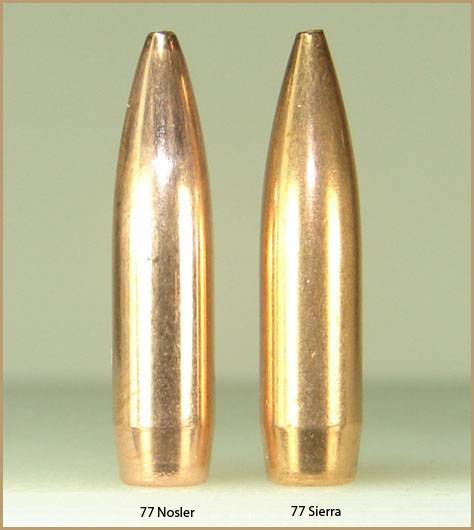
I recall an early Nosler advertisement for their Custom Competition bullet that included a phrase saying the bullet was “ideal for military and law enforcement,” hinting at the possibilities of improved fragmentation due to the thinner J4 jacket.
Thanks to the works of Dr. G.K. Roberts we know that the 77 grain Nosler bullet loaded to mil-spec velocities has superior terminal ballistic properties to that of the 77 grain Sierra MatchKing loaded in MK262. The terminal ballistic properties of the 77 grain Nosler bullet rival that of the Hornady 75 grain 5.56 TAP load. Unfortunately, there are no ammunition manufacturers that I’m aware of currently loading the 77 grain Nosler to mil-spec velocities.
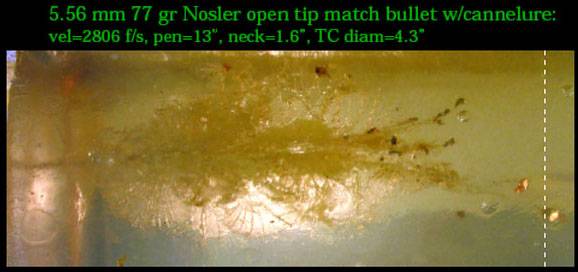
The Nosler 77 grain Custom Competion bullet is typically sold without a cannelure, however Nosler occasionally releases the bullet with a shallow cannelure similar to the one found on the 77 grain SMK loaded in MK262. The cannelured version of the 77 grain Nosler will be the focus of this report.
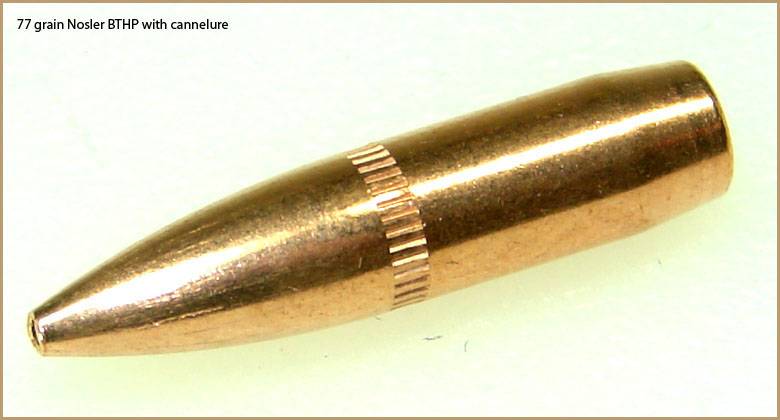
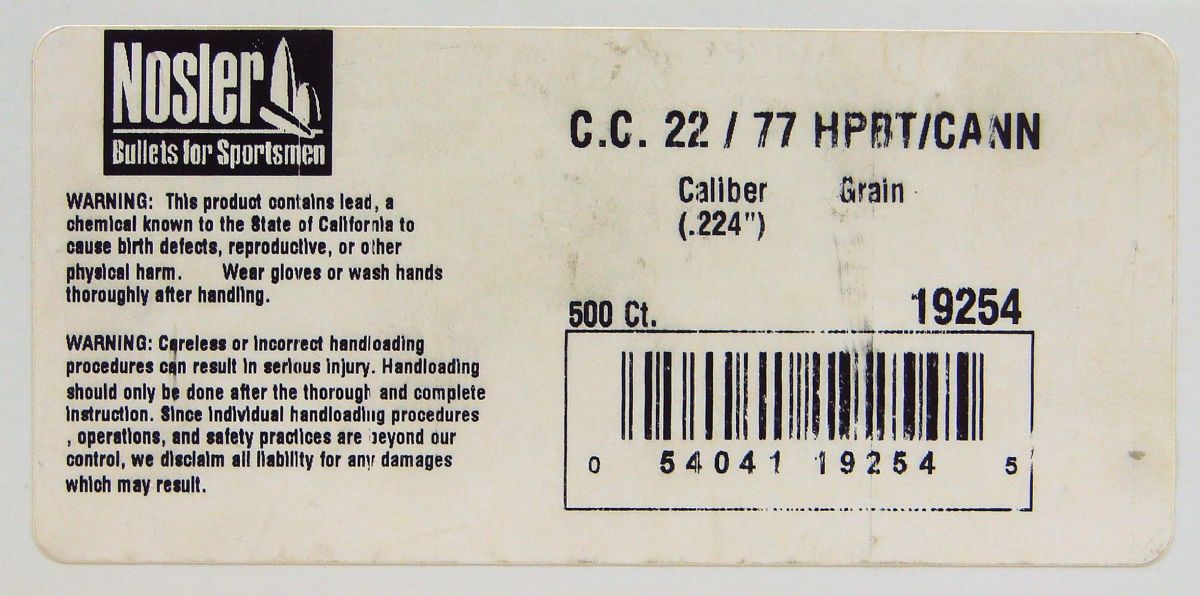
For the first phase of testing, I hand-loaded the cannelured version of the 77 grain Nosler BTHP to a typical SAAMI velocity (approximately 2600 fps from a 20” Colt barrel) to establish an accuracy baseline. No case mouth crimp was applied at this phase.
As per my usual protocol, accuracy testing was conducted from a concrete benchrest at a distance of 100 yards. For this phase of testing I used one of my 1:7.7” twist Krieger barreled AR-15s . This barrel has produced sub ½ MOA 10-shot groups with my hand-load topped with the Sierra 55 grain BlitzKing. The fore-end of the rifle rested in a Sinclair Windage Benchrest, while the stock of the rifle rode in a Protektor bunny-ear rear bag. A Leupold Competition Scope was used for testing. Wind conditions were monitored using a Wind Probe.
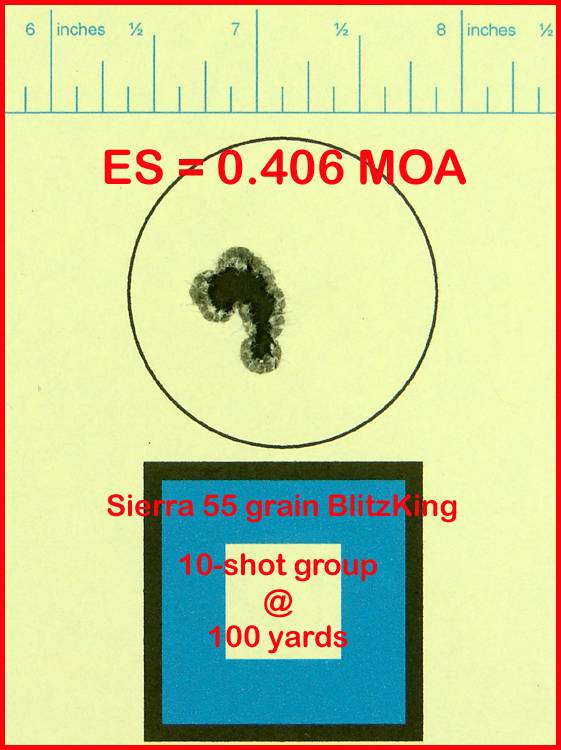
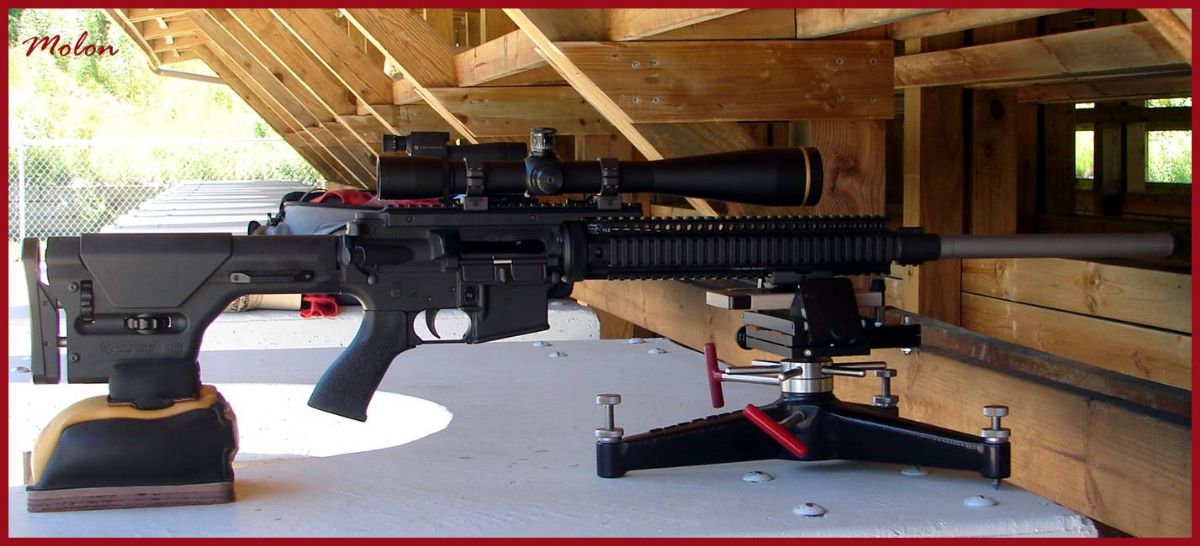
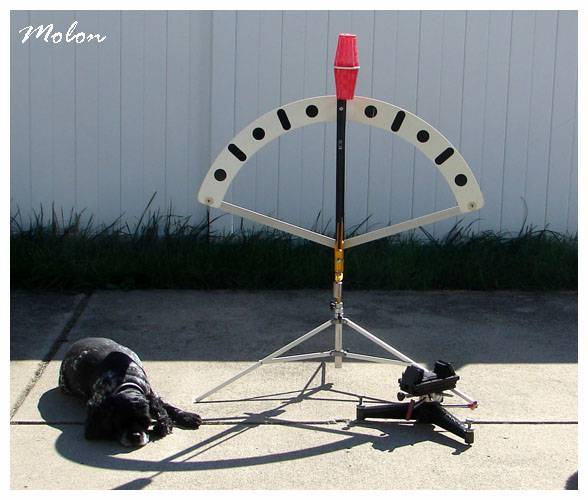
Three 10-shot groups were obtained which had extreme spreads of
0.797”
0.827”
0.812”
for a 10-shot group average of 0.812”. The three groups were over-layed on each other using RSI Shooting Lab to form a 30-shot composite group. The composite group had a mean radius of 0.26”. This test shows that the Nosler bullet itself is capable of consistent sub-MOA accuracy at 100 yards when fired from a semi-automatic AR-15.
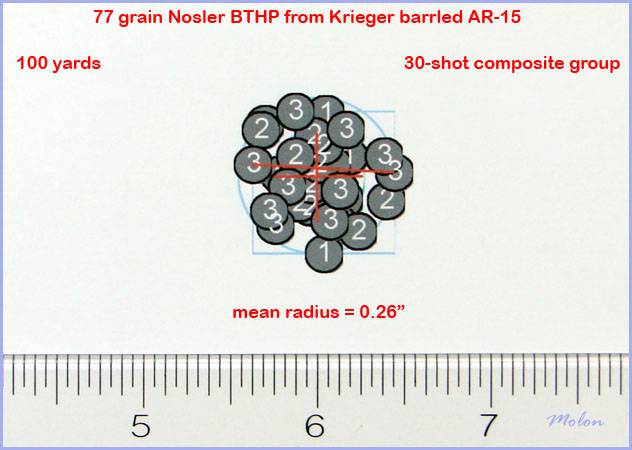
For the second phase of testing, I safely worked up a load for the 77 grain Nosler BTHP to a muzzle velocity of 2800 fps from a 20” barrel using a non-canister grade military powder which has a velocity-to-powder-charge ratio that is very close to that of the powder used in MK262. No case mouth crimp was used in this phase of testing either.
Since my Krieger barreled AR-15 has a 5.56mm Match chamber that is “a little too tight” for mil-spec pressure loads, I used my AR-15 with a 20” Noveske DCM barrel with a 1:7” twist for this phase of testing. This Noveske barrel has the “Noveske Match Mod 0 chamber which is designed to offer 100% reliability while retaining maximum possible accuracy. The chamber body is slightly larger than the 5.56mm NATO minimum, but within the 5.56 NATO tolerance. The throat is redesigned for proper bullet alignment with the axis of the bore. This chamber was developed to fire MK262 Mod 1 on AUTO in hot environments." This barrel has produced sub ¾ MOA groups with my 55 grain BlitzKing hand-load.
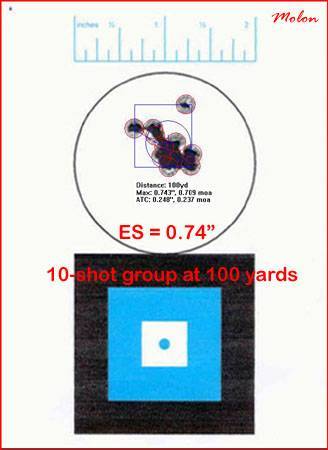

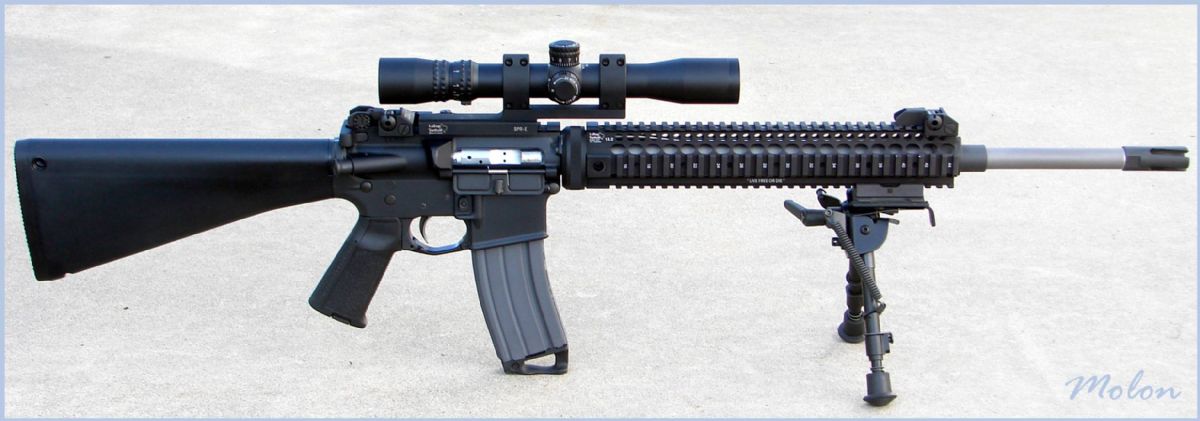
Accuracy testing using the Noveske barreled AR-15 and the mil-spec velocity load of Nosler 77 grain was conducted in the same manner as described above in the first phase of testing. Three 10-shot groups were obtained from 100 yards. Those groups had extreme spreads of:
0.880”
0.857”
0.845”
for a 10-shot group average of 0.860”! These groups were over-layed on each other using RSI Shooting Lab to form a 30-shot composite group which had a mean radius of 0.29”.
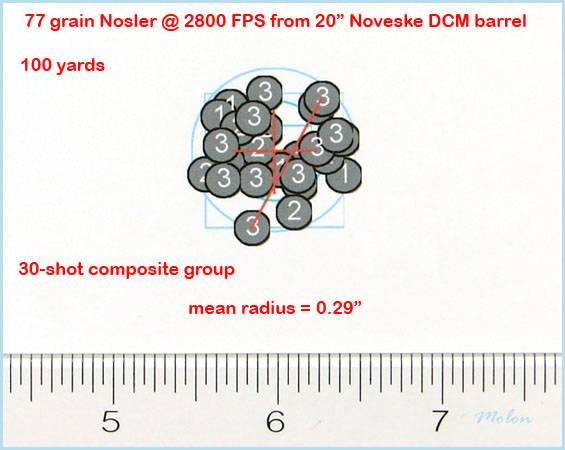
For the final phase of testing I added a taper crimp to the case mouth of the previously described load used in phase two. A 10-shot string of this load fired over the Oehler 35-P chronograph from my 20” Novekse barrel had a muzzle velocity of 2801 fps with a standard deviation of 12 fps.
Three 10-shot groups fired from 100 yards from the 20” Noveske DCM barrel had extreme spreads of:
1.033”
0.914”
1.241”
for a 10-shot group average of 1.063”. As before, the three groups were over-layed on each other using RSI Shooting Lab to form a 30-shot composite group. The mean radius for the composite group was 0.31”.
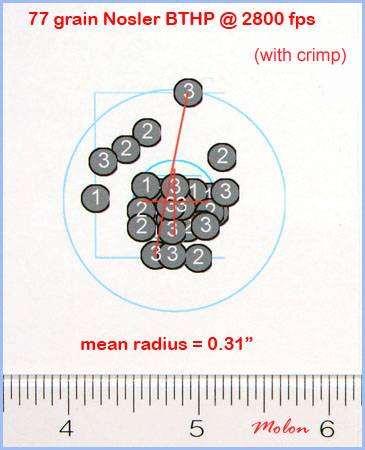
For comparison, Black Hills MK262 Mod 1 fired from my Lothar Walther barrel AR-15 had a 10-shot group average extreme spread of 1.098”. The mean radius for the 30-shot composite group of MK262 Mod 1 was 0.33”.
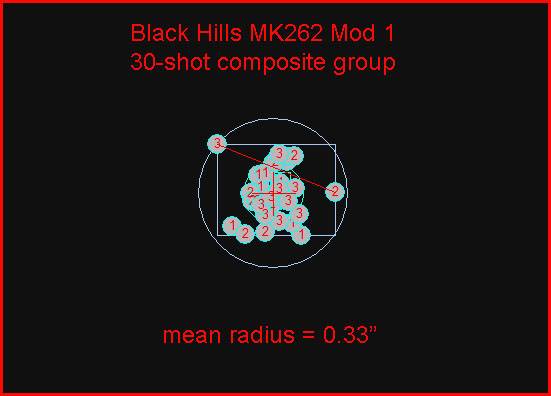
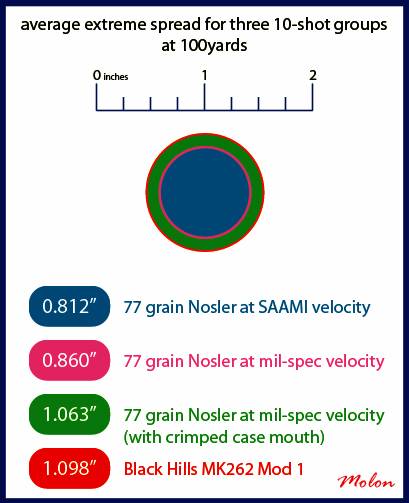
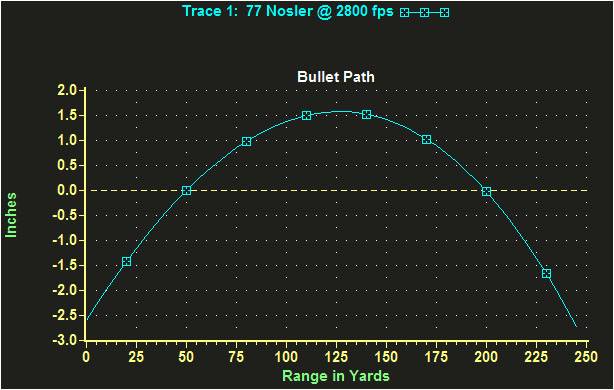

..

Nosler introduced their 77 grain Custom Competition BTHP bullet as an obvious competitor to the 77 grain Sierra MatchKing. The shape and ballistic coefficient of the Nosler bullet is very similar to that of the Sierra MatchKing. The Nosler bullet does have one major difference from the Sierra MatchKing; it is constructed using the thinner J4 copper jacket.

I recall an early Nosler advertisement for their Custom Competition bullet that included a phrase saying the bullet was “ideal for military and law enforcement,” hinting at the possibilities of improved fragmentation due to the thinner J4 jacket.
Thanks to the works of Dr. G.K. Roberts we know that the 77 grain Nosler bullet loaded to mil-spec velocities has superior terminal ballistic properties to that of the 77 grain Sierra MatchKing loaded in MK262. The terminal ballistic properties of the 77 grain Nosler bullet rival that of the Hornady 75 grain 5.56 TAP load. Unfortunately, there are no ammunition manufacturers that I’m aware of currently loading the 77 grain Nosler to mil-spec velocities.

The Nosler 77 grain Custom Competion bullet is typically sold without a cannelure, however Nosler occasionally releases the bullet with a shallow cannelure similar to the one found on the 77 grain SMK loaded in MK262. The cannelured version of the 77 grain Nosler will be the focus of this report.


For the first phase of testing, I hand-loaded the cannelured version of the 77 grain Nosler BTHP to a typical SAAMI velocity (approximately 2600 fps from a 20” Colt barrel) to establish an accuracy baseline. No case mouth crimp was applied at this phase.
As per my usual protocol, accuracy testing was conducted from a concrete benchrest at a distance of 100 yards. For this phase of testing I used one of my 1:7.7” twist Krieger barreled AR-15s . This barrel has produced sub ½ MOA 10-shot groups with my hand-load topped with the Sierra 55 grain BlitzKing. The fore-end of the rifle rested in a Sinclair Windage Benchrest, while the stock of the rifle rode in a Protektor bunny-ear rear bag. A Leupold Competition Scope was used for testing. Wind conditions were monitored using a Wind Probe.



Three 10-shot groups were obtained which had extreme spreads of
0.797”
0.827”
0.812”
for a 10-shot group average of 0.812”. The three groups were over-layed on each other using RSI Shooting Lab to form a 30-shot composite group. The composite group had a mean radius of 0.26”. This test shows that the Nosler bullet itself is capable of consistent sub-MOA accuracy at 100 yards when fired from a semi-automatic AR-15.

For the second phase of testing, I safely worked up a load for the 77 grain Nosler BTHP to a muzzle velocity of 2800 fps from a 20” barrel using a non-canister grade military powder which has a velocity-to-powder-charge ratio that is very close to that of the powder used in MK262. No case mouth crimp was used in this phase of testing either.
Since my Krieger barreled AR-15 has a 5.56mm Match chamber that is “a little too tight” for mil-spec pressure loads, I used my AR-15 with a 20” Noveske DCM barrel with a 1:7” twist for this phase of testing. This Noveske barrel has the “Noveske Match Mod 0 chamber which is designed to offer 100% reliability while retaining maximum possible accuracy. The chamber body is slightly larger than the 5.56mm NATO minimum, but within the 5.56 NATO tolerance. The throat is redesigned for proper bullet alignment with the axis of the bore. This chamber was developed to fire MK262 Mod 1 on AUTO in hot environments." This barrel has produced sub ¾ MOA groups with my 55 grain BlitzKing hand-load.



Accuracy testing using the Noveske barreled AR-15 and the mil-spec velocity load of Nosler 77 grain was conducted in the same manner as described above in the first phase of testing. Three 10-shot groups were obtained from 100 yards. Those groups had extreme spreads of:
0.880”
0.857”
0.845”
for a 10-shot group average of 0.860”! These groups were over-layed on each other using RSI Shooting Lab to form a 30-shot composite group which had a mean radius of 0.29”.

For the final phase of testing I added a taper crimp to the case mouth of the previously described load used in phase two. A 10-shot string of this load fired over the Oehler 35-P chronograph from my 20” Novekse barrel had a muzzle velocity of 2801 fps with a standard deviation of 12 fps.
Three 10-shot groups fired from 100 yards from the 20” Noveske DCM barrel had extreme spreads of:
1.033”
0.914”
1.241”
for a 10-shot group average of 1.063”. As before, the three groups were over-layed on each other using RSI Shooting Lab to form a 30-shot composite group. The mean radius for the composite group was 0.31”.

For comparison, Black Hills MK262 Mod 1 fired from my Lothar Walther barrel AR-15 had a 10-shot group average extreme spread of 1.098”. The mean radius for the 30-shot composite group of MK262 Mod 1 was 0.33”.




..

